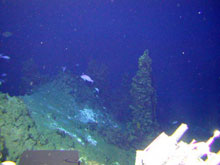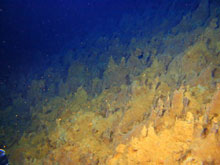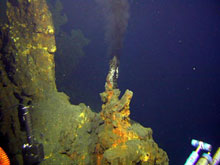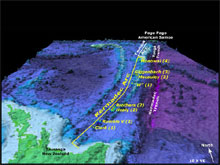
An overall image of the New Zealand American Submarine Ring of Fire 2005 expedition dive sites. The cruise track between Pago Pago and Tauranga covered over 2900 kilometers Bathymetry data sets for this image include low-resolution satellite altimetry data, and high-resolution EM300 bathymetry data in the area of the dive sites. Click image for larger view
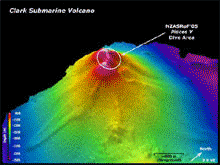
View the slide show of 3D submarine volcano images from the NZASRoF05 Leg 2 expedition dive sites. The dive areas are indicated by the white circles on the images. Click image for larger view.
![]() Click
image to view a slide show.
Click
image to view a slide show.
New Zealand American Submarine Ring of Fire 2005: Kermadec Arc Expedition Summary
May 10, 2005
Bob Embley
Co-Chief Scientist for the New Zealand American Submarine Ring of
Fire Expedition (Legs 1 and 2)
Geophysicist
NOAA Vents Program, Pacific Marine Environmental Laboratory – Newport,
Oregon
Gary Massoth
Co-Chief Scientist for the New Zealand American Submarine Ring of Fire Expedition
(Leg 1)
Principle Scientist
Institute of Geological and Nuclear Sciences Ltd
Lower Hutt, New Zealand
Read the SRoF'05 Final Cruise Report (10.2 Mb, PDF)
The NZASRoF-o5 cruise track between Pago Pago, American Samoa and Tauranga, New Zealand transited more than 2900 kilometers during the first leg, stopping at 5 volcanoes (Monowai caldera, Macauley, Giggenbach, "W", and Rumble V) for 11 Pisces V submersible dives, 2 RCV-150 remotely operated vehicle deployments, and 3 CTD vertical casts. The second leg transited over 1350 kilometers between Tauranga, New Zealand and Brothers Volcano, stopping at 4 volcanoes (Clark, Rumble V, Healy and Brothers) for 6 Pisces V dives, 2 CTD tows and 1 vertical cast. Seven moorings were also recovered at Brothers (requiring 1.5 operational days). A single potential dive day was lost to weather during the first leg and 7 days were lost during the second leg. No dives or over-the-side operations were lost to equipment malfunctions. Seventeen interdisciplinary (geology + chemistry + macro-biology + micro-biology) dives were completed, compared to 20 planned dives (85%). All but one of the targeted volcanoes were visited and an extensive suite of samples (more than 200 fluid, rock, mineral and biology samples) was collected. Monowai cone was in a period of active volcanism, as validated by acoustic monitoring by French scientists in Tahiti, therefore we determined it was not safe to visit that dive site. We thank the HURL group and the KoK personnel who worked very hard to prepare for this expedition, ensuring that the science teams got the maximum possible return from the dive programs.
Despite the weather losses, the mission was a total success.
(1) A shallow hydrothermal system at one of the Kermadec volcanoes has yielded very high total gas contents equal to the highest values measured at Mid-Ocean Ridge (MOR) sites. Boiling vents produce gas bubbles at 202° C (396° F), which is about 2 times the boiling point at sea level. These hydrothermal systems are well within the photic zone at 160-180 meters (~290-330 feet). Schools of fish interact with abundant chemosynthetic life that includes prolific microbial mats and beds of mussels.
(2) The high gas content at some arc volcanoes is accompanied on the seafloor by abundant precipitation of sulfur directly from the vent fluids and from small sulfur “flows” oozing from fractures. This high gas content is evidence for direct degassing from underlying magma chambers. This “magmatic degassing” process may be ubiquitous on submarine arc volcanoes and could lead to new insights into ore-forming processes, including a better understanding of the processes that concentrate gold and other precious and exotic metals.
(3) The extreme and varied chemical and physical conditions within the subsurface and seafloor hydrothermal systems of arc volcanoes are likely to host microbial life with unusual adaptations including new and unique enzymes. We believe that these have a high potential for developing new natural products of interest to industrial and medical research.
(3) Results from the present dives on the Kermadec Arc and from the 2004 dives on the Mariana Arc appear to show a high productivity of chemosynthetic communities relative to MOR communities. This is probably at least partly related to the enhanced level of magmatic activity of arc volcanoes which typically yields more sulfur gases.
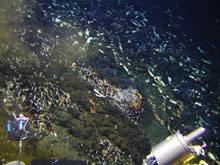
The chemosynthetic biological communities on the Kermadec Arc are dominated by mussels. Click image for larger view.
(4) The chemosynthetic biological communities on the Kermadec Arc are dominated by mussels. Although the individual communities have, from initial observations, lower biodiversity relative to MOR vents, the biomass at some sites is high and each appears to have a unique combination of macrofauna. A number of species are new records for the New Zealand region, and some may be new to science.
(5) The ongoing seismic activity of one of the Kermadec submarine volcanoes prohibited its direct study using an underwater vehicle. Since there is high potential for rich scientific rewards from making observations and sampling fluids from submarine volcanoes, this has prompted an initiative to develop new technology and methods for remote monitoring and time-series sampling of submarine volcanoes with long-term volcanic activity. Studies of extreme oceanic environments, such as active submarine volcanoes, using new exploration technology could also have important implications and lessons for future remote explorations on other planets and moons in our solar system.
(6) The extensive iron-dominated venting at Healy volcano was a surprise. Large areas (acre size) on several young volcanic cones were covered with actively forming or recently active microbial mat. As this microbial by-product ages, it forms crusts over large areas that may mimic lava flows in some places. This extensive iron-venting process and crust formation has been also been observed on NW Eifuku Volcano, on the Mariana Arc, and may be common during some stages of evolution of arc volcanoes.
(7) Brothers Volcano is an exciting laboratory for studying hydrothermal processes at arc volcanoes. There are two major types of active venting (gas-rich venting on the young cone in the southern caldera and metal rich high-temperature venting on the northwest caldera wall). This site deserves much more detailed explorations at a smaller scale and would be an ideal place to explore the evolution of a submarine ore deposit in an arc setting in both space and time.
(8) The success of the New Zealand American Submarine Ring of Fire 2005 Expedition underscores the value of international collaborations in ocean exploration, particularly those where both partners bring expertise, resources and a commitment to a multi-year effort to define sites for more focused exploration.
The submarine volcanoes of the Intraoceanic island arcs of the western Pacific remain a frontier for ocean exploration. Substantial progress has been made in multibeam mapping of the submarine volcanoes along the Mariana and Kermadec-Tonga arcs but only 15 of the more than 150 known volcanoes have been explored using remotely operated vehicles and human occupied vehicles. Furthermore, there are still at least 30 volcanoes in these regions that have known hydrothermal activity on them that have not yet been explored. Considering the astounding discoveries to date in these regions (e.g., liquid CO2 venting, first direct observations of submarine eruptive activity on an arc volcano, new ecosystems etc.), this region should remain a high priority for future explorations. About 80% of the Mariana Arc lies within the U.S. EEZ (some within the territorial waters of the Territory of Guam and the Commonwealth of the Northern Mariana Islands). Both the Mariana and Kermadec Arcs have been and will remain fruitful sites for international ocean exploration programs with Japan and New Zealand. The submarine volcanoes of the Tonga Arc (lying within the EEZ of Tonga and Western Samoa) are virtually unexplored, as are numerous submarine areas along the small intraoceanic arcs lying within the triangle between Australia, New Guinea and Fiji.
Sign up for the Ocean Explorer E-mail Update List.



























